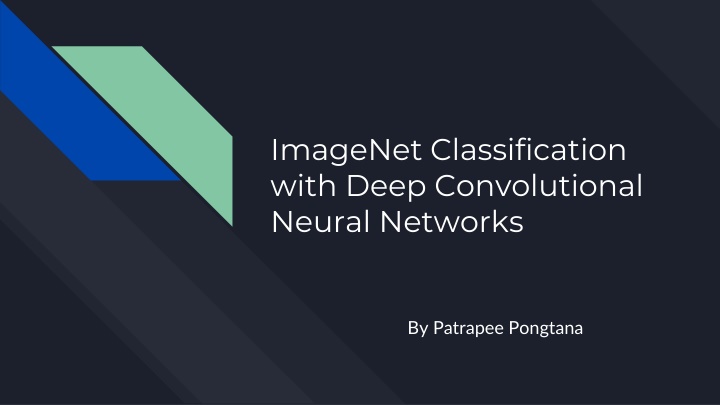
Achieving Fast and Robust ImageNet Classification with Deep CNNs
"Explore the architecture, activation functions, GPU utilization, and conclusion of a deep convolutional neural network designed for ImageNet classification. Discover the importance of specific layers, ReLUs, GPUs, dataset size, and more in optimizing performance and accuracy."
Download Presentation

Please find below an Image/Link to download the presentation.
The content on the website is provided AS IS for your information and personal use only. It may not be sold, licensed, or shared on other websites without obtaining consent from the author. If you encounter any issues during the download, it is possible that the publisher has removed the file from their server.
You are allowed to download the files provided on this website for personal or commercial use, subject to the condition that they are used lawfully. All files are the property of their respective owners.
The content on the website is provided AS IS for your information and personal use only. It may not be sold, licensed, or shared on other websites without obtaining consent from the author.
E N D
Presentation Transcript
ImageNet Classification with Deep Convolutional Neural Networks By Patrapee Pongtana
The Architecture Eight learned layers Five convolutional Three fully-connected Goal Accomplish the training the dataset as fast as possible while maintaining the robust of the model
Rectified Linear Units (ReLUs) Standard model without ReLUs is The model with ReLUs activation function is By using ReLUs and trained on four-layer convolutional network, the result is shown below
Traditional Activation Functions Sigmoid Function: tanh Function:
Not Fast Enough? Add more GPUs! GPU has a big role in term of computation speed Some GPUs, such as GTX 580, is capable of cross-GPU paralleization It can read and write memory without a delay from host memory Cross-validation should be considered
Conclusion If one convolutional layer is removed, then the performance massively decreased. Thus, this specific architecture will be strictly tie to this accuracy The longer and larger dataset we can obtain, the better performance we will get
